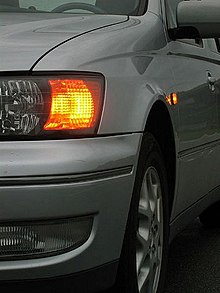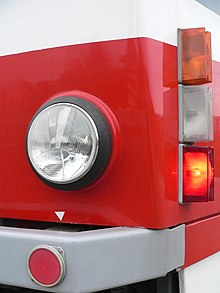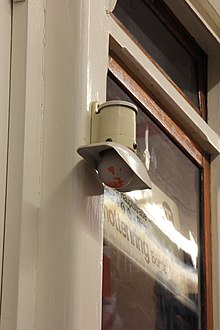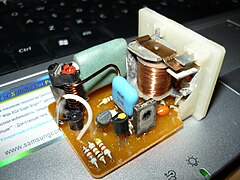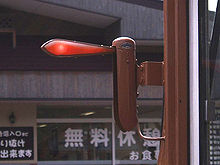Direction indicators



The direction indicator (Austria and Germany) and the direction indicator (Switzerland) is a lighting device of motor vehicles and trams , serving road users in the road for information about a change in the direction of travel or the announcement this. This is usually implemented as a flashing light . It is known colloquially as a blinker and is part of the vehicle lighting . Self-resetting turn signals are the automatic switching off after the end of the turning process.
A second use of the direction indicator (but in a modified circuit, namely all 4) is the hazard warning flashers , in Austria also alarm flashers.
Equipment regulations
In single and multi-lane vehicles , a flashing light is required on each side at the front and rear, and only at the rear for trailers . However, many modern multi-lane vehicles have more than these four direction indicators, namely one each on the front fenders or in the exterior mirrors . Exceptions exist for single-axle tractors and work machines, light motorcycles, mopeds and bicycles with auxiliary engines (as well as single-axle trailers on motorcycles) and wheelchairs. The indicators are not required on these vehicles, but if they are still present, they must comply with the regulations (in Germany § 54 StVZO ). On vehicles with a length of no more than 4 m and a width of no more than 1.60 m, direction indicators on the two long sides are sufficient. On vehicles where the distance between the facing outer edges of the light-emitting surfaces of the indicators on the front and rear is more than 6 m, additional direction indicators must be attached to the two long sides. In many vehicles, especially larger ones, they are duplicated because of the reliability and better visibility. There are also EC directives, for example, on the installation of direction indicators on two-wheeled vehicles. In Switzerland, the installation of direction indicators is regulated in detail in the Ordinance on the Technical Requirements for Road Vehicles VTS (SR 741.41).
Light and flashing frequency
When switched on it flashes in Germany according to § 54 StVZO or ECE-R 48, in Switzerland according to Art. 79 Para. 2 VTS on the respective side in phase with a frequency of 1.5 Hz ± 0.5 Hz (90 light phenomena per Minute ± 30). The indicators must light up after 1.0 seconds in Switzerland or after 1.5 seconds in Germany after pressing the direction switch.
In Germany, the flasher unit has to cycle in such a way that the relative brightness of the flasher lights is 30% to 80%. It is not necessary that the blinking rhythm begins with the so-called light phase.
Regarding a control system, the regulation in Switzerland is liberal. There must be an acoustic or optical control device which indicates the function ( Art. 79 Para. 3 VTS). In Germany it is regulated in much more detail: If the indicators cannot be seen directly by the driver, the driver's field of vision - e.g. B. on the dashboard - in the same frequency, in phase or in phase opposition, one for both sides of the vehicle or two for each side of the vehicle light up the indicator light and / or the function of the turn signal is displayed in a different, unmistakable way.
Most of the time, car manufacturers equip an audible feedback in parallel to a visual display by means of a green indicator light, in that the indicator relay clicks audibly or the instrument cluster produces appropriate indicator tones . This control tone was previously generated by a relay , since the switch to electronic control, this tone has been imitated by a loudspeaker. If one of the indicators fails, the indicator light then lights up at a significantly faster frequency; if there are two indicator lights, only the one on the relevant side of the vehicle.
colour
In general, yellow light is prescribed for the direction indicator, although in some countries, for example in Switzerland, the USA or Canada, a red light at the rear is also permitted. It can be switched brake lights. This makes it possible to use the same lamp as the indicator, brake and tail light. Since they lack the green component in the color spectrum, they do not develop the brightness of yellow flashing lights and two redundant light sources can be used in the light. In Switzerland you can usually see this version with direct imports from the USA.
In Germany there used to be a few red flashing lights. These are still permitted if the vehicle was first registered before December 31, 1969. Both yellow and red indicators are allowed in Switzerland. The year of construction does not matter. According to a study by the NHTSA, yellow flashing lights are better than red ones in order to avoid accidents .
Further regulations
When towing trailers , an additional control function must also be available for the trailer's turn signal. This can be done with an additional control lamp or via electronics that increase the flashing frequency if one lamp fails.
On some vehicles, the hazard warning lights are switched on automatically when the vehicle brakes abnormally, see adaptive brake light .
Vehicles with remote-controlled door locking usually use the indicators as a visual control, which signals whether the vehicle has been locked or unlocked.
Usage regulations
When starting up and turning, the light must be activated in good time (see below) and clearly (at least three times). This does not apply to kinking right of way, provided that this is followed. If you continue straight ahead and thereby leave a kinking priority road, in many cases there should not be any blinking. (Activating a blinker while following a bend in the priority road would confuse other road users.)
The change of lane (on multi-lane roads such as motorways ) must also be announced by the corresponding direction indicator lighting up at least three times before changing lanes (in Germany: § 7 StVO ). In the area of intersections, this is usually not done in order to avoid confusion with turning requests.
At the roundabout , which has sign 215 (roundabout) at the junctions in Germany, there is no blinking when entering the roundabout according to § 8 StVO, although it is formally a turn to the right, which must also be prepared in the same way (mirror look, look around ). Flashing when entering a roundabout marked in this way is not allowed, so that other drivers do not think that the driver wants to take the first exit - and it is also not allowed when he wants to take this , so that other drivers do not think that he just has accidentally set the not allowed blinker because of the roundabout. The regulation in Austria is similar with the difference that flashing is allowed when entering the roundabout. In Switzerland, when entering the vehicle, it must flash when the first exit is taken.
If a road user is overtaken, the overtaking process must be indicated by actuating the left turn signal before it is carried out. After the overtaking maneuver, the right-hand direction indicator must be operated to indicate a turn into the right-hand lane. If single-track vehicles such as a bicycle or a moped are overtaken, the overtaking process must also be made visible by activating the direction indicator before and after the overtaking process.
It should be defined in good time that the other road users can adjust to the turning or lane change process. The distance to the turning point is less important than the time. In terms of Germany, the Federal Court of Justice finds that operating the direction indicator five seconds in advance at a speed of 30 km / h is sufficient. - Somewhat more practical is the recommendation to always start with the flashing before you turn the steering wheel to deviate from the previous traffic flow, or before you take your foot off the accelerator or even brake. If the latter actions take place when approaching a red traffic light, one behaves with regard to the flashing as if the traffic light was green.
In general, the direction of travel display should always represent an announcement that the vehicle will shortly change its direction of travel or the lane. The announcement is intended to avoid surprise effects for other road users so that there are no hectic or panic reactions; everything in terms of road safety. Therefore, the display must start early enough so that everyone can adjust to it. This is the most important method of communication between road users.
This is why (as an exception) there is no blinking if you change lanes at an intersection but stay on the road: that is, the other road users do not mean that you want to turn. If it is not possible to change lanes safely without blinking, you must wait until a certain distance from the intersection is reached.
service
Cars and trucks
In the vast majority of cars, the turn signal lever is attached to the steering column in a horizontal resting position. To activate it, the driver takes the lever a short distance in the respective direction when turning the steering wheel. However, this tempts many drivers to actually only set the indicator at the beginning of cornering and not a time in advance as necessary in order to give a regular advance warning.
There are two different positions on each side for activating the direction indicator: On the one hand, the permanent position up to the respective end stop, which is only returned to the rest position by manual intervention or the automatic turn signal reset when turning out of the curve. This position is used when turning and when approaching or leaving the edge of the road. - On the other hand, there is a position with a noticeable intermediate pressure point in front of this locking position, in which the indicator is already activated, but when it is released it immediately returns to its rest position by spring force. This position is mainly used for flashing when changing lanes.
In view of the requirement to flash clearly and in good time, there are already versions that trigger this behavior with a brief tap on the lever (so-called comfort flashers). Until now, when changing lanes, for example, the driver had to hold the indicator lever in the unlocked position for so long, which can be inconvenient and dangerous when steering and is therefore often neglected. In the times of electronic flasher devices, this is a relatively easy-to-implement behavior. A single flash could also be interpreted as an accidental operating error.
In most car models, the switch for the hazard warning lights is visually highlighted (red warning triangle ). With many manufacturers this switch is located in the center console or at the level of the air outlet nozzles. In the late 1980s in particular, it was fashionable to place the switch on the steering column. However, this has been deviated from today. Until recently, this switch was also found near the gearshift lever in BMW and Renault models. With some models there was also the so-called control satellite . Mistakes often led to misunderstandings in earlier Fiat Panda / Seat Marbella models - there the hazard warning switch was a red steering column switch . Likewise in the Audi 80 B3 .
If a direction indicator is active, either ↔ is displayed (illuminated) or, more modern, ← and → , depending on the circuit , on the instrument panel .
motorcycles
The turn signal switch is located next to the switches for the horn and the lighting mainly on the left handlebar switch. The turn signal switch is usually designed in the form of a lever switch: pressing to the left or right activates the respective direction indicator. Pushing it in deactivates the turn signal. On some motorcycles (e.g. on some models from BMW) the indicator switches are located separately on the left and right. Only a few motorcycles have automatic turn signal resetting after turning out of a curve.
In newer models, the switch for the hazard warning lights is often attached to the right handlebar switch. With the Zündapp KS 80 there was the special design of the alternating current flasher relay (6V), which let the indicators on the respective vehicle side light up alternately at the front and rear in order to protect the NC batteries of the charging system. This design was only permitted for light motorcycles.
When the direction indicator is activated, this is indicated on the instrument panel with a flashing light. Some models also have a display that shows the active direction of the direction indicator. The ox-eye is a rare form .
Blinkers
In 2008, a study by the Auto Club Europa observed the blinking behavior of 394,000 vehicles at 700 intersections in Germany. About a third of the vehicles did not blink according to the road traffic regulations, in the case of kinking priority roads it was 45%. France follows with 27 percent, followed by other European countries. This is not only uncomfortable for other road users, but can also trigger traffic accidents. If you do not blink, you must expect a warning or a fine (in Germany, among other things, according to § 49 1 point 9 StVO).
technology
Inside of a discreetly constructed car flasher relay
The technology of the flasher has changed several times over the years.
- In historical motor vehicles , the flasher unit contained a bimetallic strip that was wrapped with a heating wire.
- Another variant of the flasher unit was the hot-wire flasher unit, in which the change in length of a heating resistor wire stretched between a ground contact and the rocker switch of a relay was used.
- Another variant were electro-pneumatic flasher relays , which appeared around the mid-1960s, but were quickly replaced by electronic designs.
- In the electronic flasher unit there is an astable multivibrator , which is followed by a relay and a measuring resistor to detect the electrical current . The latter can recognize the failure of a light bulb , which the flasher unit signals by increasing the flashing frequency.
- In more recent versions, a microcontroller , programmed by its firmware , controls the timing and can also implement higher functions, such as flashing at least three times, even if the gearshift lever was only tapped (convenience flashing). A microcontroller (possibly another one in the instrument cluster ) can also control the built-in sounder for acoustic feedback to the driver.
Hazard warning light
Regulations in Germany
In addition to the normal display of the change in direction of travel, the blinker is also used as a warning device and is referred to as a hazard warning flasher . In this case, all indicators flash simultaneously, regardless of the failure of one or more indicators and regardless of whether the vehicle's ignition is switched on or not. When the vehicle is at a standstill, they serve to protect against traffic accidents (in Germany: § 15 StVO). When driving, the hazard warning lights are used in Germany to warn the following traffic when the columns suddenly brake (for example when approaching the end of a traffic jam, § 16 StVO).
Rescue workers may also use the switched on hazard warning lights to show other emergency services that the battery of a vehicle that has crashed has not yet been disconnected. In this case, this represents a warning of electricity, the risk of fire and the possibly not yet deployed airbag.
When the hazard warning lights are switched on, the function must be indicated by a red control light in the driver's field of vision; a triangle with an exclamation mark in it in the hazard warning switch itself is common, which then flashes alternately with the control lights for the direction indicator (in Germany: § 39a and § 53a StVZO).
The use of the hazard warning lights is mandatory for individuals:
- a breakdown ( § 15 and § 15a StVO),
- when towing (the towed vehicle, as long as at least one axle rolls along on the road) ( § 15 and § 15a StVO),
- for school and public buses. The driver of a regular bus or a marked school bus must turn on the hazard warning lights when approaching a stop where the road traffic authority has specially ordered such behavior and then leave it on until the passengers have got on and / or alighted ( § 16 StVO).
§ 20 StVO then prescribes: as long as the bus with activated warning flashers drives up to the stop, he can not be overtaken, only when he has stopped (that may be used in both directions and the oncoming traffic) with walking speed are driven past this. Only on roads with (structural) lane separation (by guardrail, green verge, median , etc.) does the speed limit for oncoming traffic do not apply.
In addition, hazard warning lights may only be switched on to warn of a hazard (e.g. approaching a traffic jam on the motorway, last vehicle in the column, accident, endangering others from your own vehicle), § 16 StVO.
Regulation in Austria
On school buses in Austria there is a regulation on the use of the flashing system to protect children getting on and off. In this case, the right and left direction indicators flash simultaneously. The following vehicles are not allowed to drive past the stationary school bus in Austria , but must stop.
Regulation in Switzerland
The hazard warning light may only be used to draw the attention of other road users to a particular danger:
- if a broken-down or an accident vehicle cannot be removed immediately so that it is an obstacle for other road users,
- if the other road users are to be notified of an imminent threat of danger
- when approaching a traffic jam
- when towing on motorways and motorways.
Historical
Originally there were no electric lights, but so-called indicators , which were first manually extended from the side and later with an electromagnet .
In 1922, the first direction indicators were installed as arm indicators in a housing, which were still moved using Bowden cables . Before that, there had been various attempts with direction indicators made of painted sheet metal, which were pushed out of the vehicle by hand. The direction indicator was invented by Eugen Zipperle and August Nagel , who also received utility model protection for the arm indicator with housing in 1924. At that time there was also a "housing direction indicator" that could be turned to the left or right as an arrow at the front and rear of the vehicle in a small housing behind a pane of glass. Lighting was also tested.
In 1925, Robert Bosch built the first electric fold-out and additionally illuminated direction indicator, which did not, however, commute. Alfred Schwarz introduced the first electric swinging arm waver in 1927.
In the years from 1936 onwards, all of the trucks were equipped with an arm winker . In winter when there was snow and moisture, the arm indicators froze in the housing. When the speeds of the cars became generally higher, the wind caused difficulties in unfolding the direction indicator. In the USA , flashing lights were used as direction indicators from around 1938. American vehicles that came to Germany during the war were equipped with flashing lights and did not need to be converted.
From the 1950s onwards, Bosch built electrical "blinker" systems and lights as an alternative to the indicators that had been customary up to that point, and many motor vehicle owners voluntarily converted the old arm indicators. In the road traffic regulations it was prescribed until 1956 that a direction indicator had to change the contour of the vehicle. At that time there were pendulum angles for trucks that moved up and down when unfolding. From 1956, only indicators were required for new cars and trucks. In the Federal Republic of Germany, by July 1, 1963, all vehicles over 4 m in length and 1.6 m in width had to be provided with flashing lights on the front and rear; at the same time, the direction indicators could also continue to operate. From 1963 the hazard warning lights were approved in motor vehicles in order to be able to give a warning signal if the vehicle breaks down or breaks down, as so-called "double flashing". From January 1, 1973, older vehicles also had to have hazard warning lights.
The introduction of direction indicators was not without controversy at the time. In relation to the mandatory introduction of the same for motorcycles, the journalist Carl Hertweck wrote in 1960: "Superfluous and dangerous (...) The good driver drives in such a way that every man behind and every person coming in the opposite direction must see what he wants from his driving style."
literature
- Flashing light signal systems for motorcycles and scooters. In: Motor Vehicle Technology 10/1955, pp. 359–361.
Web links
Individual evidence
- ↑ https://www.admin.ch/opc/de/classified-compilation/19680244/index.html
- ↑ Directive 93/92 / EEC
- ↑ http://www.zeit.de/auto/2013-04/motorgeraeusche-sounddesign/komplettansicht The car door says quietly plop for a while online
- ↑ Ordinance on technical requirements for road vehicles , see "Appendix 10" or page 275.
- ↑ https://crashstats.nhtsa.dot.gov/Api/Public/ViewPublication/811115
- ↑ http://www.gvn.de/?seite=taxi/home&beitrag=222/334
- ↑ BGH VRS 25, 264; u. a. with reference to this decision KG judgment of 6 December 2004 , Az. 12 U 21/04, full text, Rn.4.
- ↑ Sole or partial liability threatens - Blink grouches endanger traffic , n-tv.de of July 10, 2008.
- ↑ Blink, little brother, blink! In: sueddeutsche.de. November 2, 2015, accessed March 14, 2018 .
- ↑ Traffic myths : what is allowed and what is not. 4. You don't have to blink. In: süddeutsche.de. August 6, 2015, accessed August 26, 2015 .
- ↑ dpa: German drivers don't like blinkers. In: FAZ.net . July 10, 2008, accessed October 13, 2018 .
- ↑ “Turn me on” campaign - the blinker has no chance. (PDF) Argumentation paper for the local press and public relations work of the ACE circles. ACE Auto Club Europa, Public Relations, February 28, 2008, accessed August 26, 2015 .
- ↑ Volkswagen Genuine comfort indicators. Volkswagen AG , accessed April 16, 2014 .
- ↑ a b A Century of Automotive Technology - Commercial Vehicles. VDI-Verlag, 1987, ISBN 3-18-400656-6 , page 371.
- ↑ a b A Century of Automotive Technology - Passenger Cars. VDI-Verlag, 1986, ISBN 3-18-400620-4 , page 323.
- ↑ Chronicle of Technology. Weltbild-Verlag, 1997, ISBN 3-86047-134-1 , page 417.
- ↑ Carl Hertweck : The copper worm. Stuttgart 1961. Second edition, 2006: p. 380.
